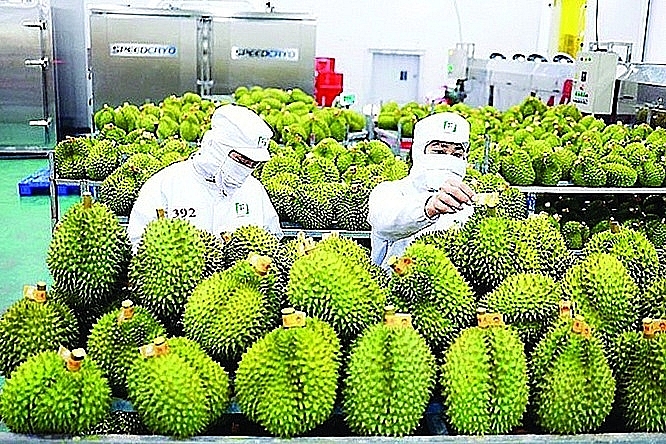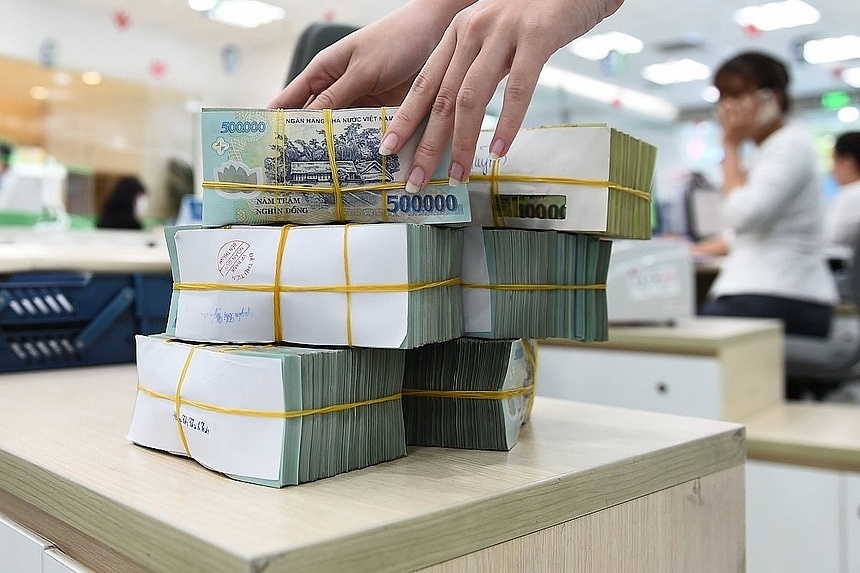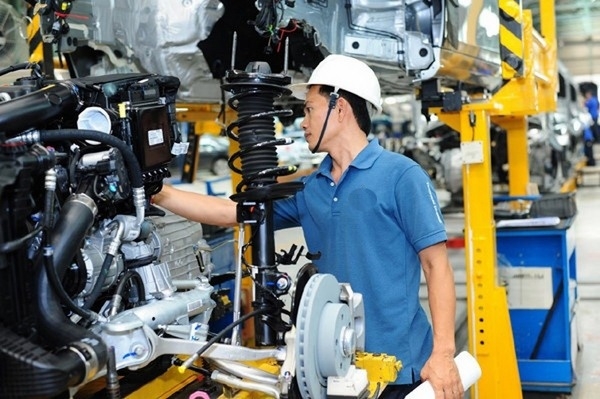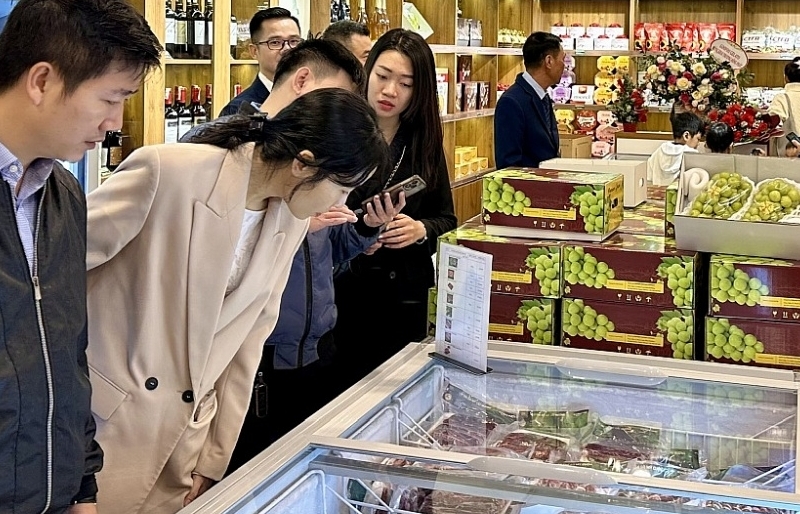Exports: Looking back and moving forward – Part 2: Agricultural products win big - pillar of exports in 2023
| Fruit, vegetable exports expected to flourish in 2024 | |
| Ho Chi Minh City holds the leading position in exports | |
| Export: Looking back and moving forward – Part 1: A difficult year |
 |
| Durian is a product that had contribute a great contribution to the agricultural industry's impressive export results in 2023. Photo: Internet |
Continuing to be a pillar of the economy
Despite failing to reach the target of US$54billion in 2023, the agricultural, forestry and fishery exports recorded the highest trade surplus in recent years and accounts for over 42.5% of the country's trade surplus. In the context of many difficulties and challenges, especially in the export market of forestry and aquatic products, in 2023 GDP growth of the entire agricultural sector was estimated to reach 3.83%, the highest rate in recent years. Agriculture continues to affirm its important position as a pillar of the economy, ensuring food security, major balances of the economy and contributing to macroeconomic stability.
Accordingly, the agricultural sector recorded an export turnover of over US$53 billion and saw a trade surplus of over US$11 billion. This is the highest level in recent years and accounts for over 42.5% of the country's trade surplus.
To this date, the agricultural sector has had six items reaching over US$3 billion in export turnover, including: coffee, rice, vegetables, cashew nuts, shrimp, wood and wooden products. This year, agricultural, forestry and fishery exports have strong differentiation between groups and products. Notably, the agricultural sector not only broke the record of export turnover, the average export price of some main agricultural products also exceeded many previous records such as: rice rose by 17.3%; tea rose by 8.7%; and coffee rose by 11.9%.
As a product continuously breaking records in exports, Vietnamese rice is increasingly asserting its position in the market though the rice growing area has decreased said by Deputy Minister of Agriculture and Rural Development Hoang Trung. Vietnamese rice has been recognized by the international community as one of the best types of rice in the world, meeting food safety conditions. Vietnam's average annual rice output reaches 43-45 million tons, equivalent to about 26-28 million tons of rice, of which about 20 million tons is for domestic market and the rest is for export.
In 11 months of this year, Vietnam exported 7.8 million tons of rice, earning US$4.4 billion. This are record number, the highest since 1989 and is expected to continue to increase in the near future. According to Mr. Do Ha Nam, Vice President of the Vietnam Food Association (VFA), 2023 can be said to be a successful year for the rice industry with two new records of the highest price and rice output peaking at 8 million tons. It is estimated that by the end of 2023, the rice industry is forecast to reach US$5 billion. "This is the first year that Vietnam exported 8 million tons of rice," Vice President of VFA said.
Improving quality to take full advantage
Not only rice, but Vietnamese vegetables, tubers, and fruits are breaking the "curse" of plenteous harvest but low prices. Even many Vietnamese agricultural products are increasingly familiar with the global community and recording impressive export numbers this year. As the "bright star" of exports in 2023, it can mention fruits and vegetables which recorded the highest export growth of the entire agricultural sector in recent times. The export value of this industry has so far exceeded the historical record of US$3.81 billion in 2018. The Vietnam Fruit and Vegetable Association forecasts that fruit and vegetable exports in 2023 are expected to reach about US$5.5-5.6 billion. This is a record level for this industry ever. China is still the leading importing market of Vietnamese fruits and vegetables, accounting for 66%, followed by the US, South Korea and Japan.
International integration opens up many opportunities to promote the export of key agricultural products thanks to tariff reductions such as rice, coffee, pepper, cashew, seafood, and vegetables. Vietnam's agricultural and aquatic products have many opportunities to choose suitable markets and partners, and have more advantages in trade. Besides, with advantages in agriculture and natural conditions, Vietnamese agricultural products have certain strengths to compete with others in the world market.
Currently, Vietnam has signed free trade agreements (FTA) with more than 60 markets, including major economic partners such as China, the European Union (EU), South Korea, Japan, England, Russia... Therefore, Vietnam has become an important link in the global agricultural value chain, among the 15 largest agricultural exporters in the world and ranked 2nd in Southeast Asia.
According to the assessment of the Ministry of Industry and Trade, the Vietnam-EU Free Trade Agreement (EVFTA) has been opening a big door for Vietnamese agricultural products to penetrate deeply into the EU market. Specifically, for rice products, Vietnam has more competitive advantage than other countries such as Cambodia, Thailand, and India thanks to preferential tariffs from EVFTA. Also thanks to EVFTA, Vietnam has 94% of tax lines for fruits and vegetables eliminated, creating more competitive advantage than Thailand and China.
In addition, the Comprehensive and Progressive Agreement for Trans-Pacific Partnership (CPTPP), the Free Trade Agreement between Vietnam and the United Kingdom of Great Britain and Northern Ireland (UKVFTA), The Regional Comprehensive Economic Partnership (RCEP) Agreement also create many advantages for Vietnamese agricultural products. In particular, the UKVFTA has helped increase the advantage of Vietnamese goods compared to ASEAN countries.
To continue to maintain the export market as well as take advantages brought by FTAs, Vietnamese agricultural products need to meet increasingly high export quality standards. In the near future, the consumer market for agricultural products will turn to energy-saving, environmentally friendly products, and social responsibility requires that agricultural, forestry, and fishery products be exploited reasonably, thereby providing corresponding standards on the origin of products such as seafood, vegetables, wood...
In addition, countries and consumers around the world are setting goals for sustainable development and reducing carbon emissions. Vietnamese agricultural products are facing the risk of taxing on products with high emissions. This is a challenge for Vietnam's agricultural exports while the system of traceability and exploitation management has not been methodically implemented, many agricultural enterprises have begun innovation to adapt with new context. In addition, agricultural products will also face many trade barriers and import policies of countries with strict requirements on food quality and safety, traceability, environmental protection, and food safety and consumer health, international environmental and social commitments.
(Final part: Be proactive about opportunities and risks from the market)
Related News

Complying with regulations of each market for smooth fruit and vegetable exports
13:06 | 09/01/2025 Import-Export

Outlook for lending rates in 2025?
15:20 | 31/12/2024 Finance

Industrial production maintains rapid and throughout bounceback
15:20 | 31/12/2024 Import-Export

Request for price management and stabilization, avoiding unusual fluctuations during Tet 2025
13:56 | 30/12/2024 Headlines
Latest News

Việt Nam tightens fruit inspections after warning from China
08:01 | 15/01/2025 Import-Export

Brand building key to elevate Vietnamese fruit and vegetable sector: experts
08:00 | 15/01/2025 Import-Export

Freight transport via China-Việt Nam cross-border trains posts rapid growth
08:01 | 13/01/2025 Import-Export

Vietnamese retail industry expects bright future ahead
06:22 | 11/01/2025 Import-Export
More News

Fruit and vegetable industry aims for $10 billion in exports by 2030
15:12 | 07/01/2025 Import-Export

GDP grows by over 7 per cent, exceeds target for 2024
15:11 | 07/01/2025 Import-Export

Vietnamese pepper: decline in volume, surge in value
15:10 | 07/01/2025 Import-Export

Việt Nam maintains position as RoK’s third largest trading partner
15:09 | 07/01/2025 Import-Export

Greater efforts to be made for stronger cooperation with European-American market
15:08 | 06/01/2025 Import-Export

Leather, footwear industry aims to gain export growth of 10% in 2025
15:06 | 06/01/2025 Import-Export

Grasping the green transformation trend - A survival opportunity for Vietnamese Enterprises
14:53 | 06/01/2025 Import-Export

Việt Nam to complete database of five domestic manufacturing industries in 2026
20:57 | 05/01/2025 Import-Export

Logistics firms optimistic about growth prospects in 2025: Survey
20:54 | 05/01/2025 Import-Export
Your care

Việt Nam tightens fruit inspections after warning from China
08:01 | 15/01/2025 Import-Export

Brand building key to elevate Vietnamese fruit and vegetable sector: experts
08:00 | 15/01/2025 Import-Export

Freight transport via China-Việt Nam cross-border trains posts rapid growth
08:01 | 13/01/2025 Import-Export

Vietnamese retail industry expects bright future ahead
06:22 | 11/01/2025 Import-Export

Complying with regulations of each market for smooth fruit and vegetable exports
13:06 | 09/01/2025 Import-Export
